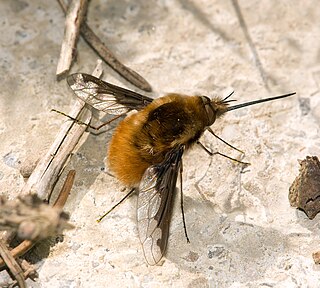
The Bombyliidae are a family of flies, commonly known as bee flies. Some are colloquially known as bomber flies. Adults generally feed on nectar and pollen, some being important pollinators. Larvae are mostly parasitoids of other insects.
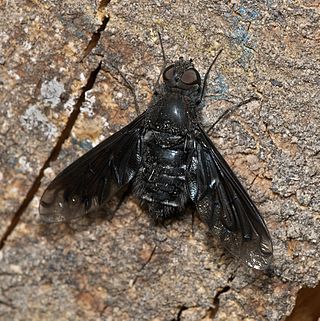
Anthrax is a genus of bombyliid flies, commonly known as "bee-flies" due to their resemblance to bees. Most are dull black flies, and are usually small to medium in size, 4–20 millimetres (0.2–0.8 in), and many species have striking wing patterns.

The Asiloidea comprise a very large superfamily insects in the order Diptera, the true flies. It has a cosmopolitan distribution, occurring worldwide. It includes the family Bombyliidae, the bee flies, which are parasitoids, and the Asilidae, the robber flies, which are predators of other insects.
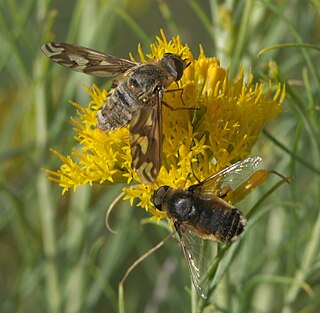
Poecilanthrax willistoni, Williston's bee fly or sand dune bee fly, is a member of the Bombyliidae insect family. This family includes the bee flies, true flies that have developed Batesian mimicry characteristics to avoid predators. That is, they look like bees because that helps them avoid bee-wary predators, but they lack stingers.

A planidium is a specialized form of insect larva seen in the first-instar of a few families of insects that have parasitoidal ways of life. They are usually flattened, highly sclerotized (hardened), and quite mobile. The function of the planidial stage is to find a host on which the later larval instars may feed, generally until the insect pupates.

Bombylius major is a parasitic bee mimic fly. B. major is the most common type of fly within the Bombylius genus. The fly derives its name from its close resemblance to bumblebees and are often mistaken for them.

Exoprosopa is a large cosmopolitan genus of flies belonging to the family Bombyliidae (bee-flies), with over 325 described species. The genus parasitizes a wide range of insects, including locust and larvae of wasps.

Apystomyiidae is a small family of flies containing the living genus Apystomyia and the extinct genera Apystomimus and Hilarimorphites. The single living Apystomyiidae species, Apystomyia elinguis, is native to California. Species of Hilarimorphites have been described from Mid to late Cretaceous Burmese and New Jersey ambers, while the single Apystomimus species is from the Late Jurassic of Kazakhstan.

Marleyimyia xylocopae is a species of bee fly from South Africa that has a similarity to the patterning of a carpenter bee Xylocopa flavicollis(De Geer, 1778) found in the region. The species is considered to be distinctive and only one of three within the genus Marleyimyia. The other members of the genus are Marleyimyia goliath described from Peninsular Malaysia and M. natalensis from southern Africa. Members in the genus have been presumed to be crepuscular or nocturnal but this species was found to be diurnal.
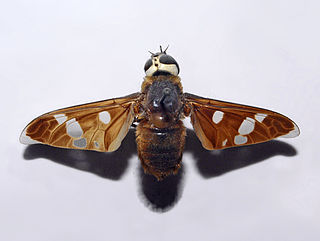
Hyperalonia is a genus of bee flies in the family Bombyliidae.
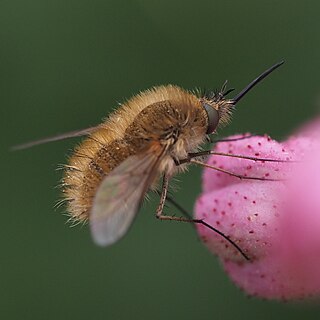
Bombylius canescens, commonly known as the western bee-fly, is a species of bee-fly belonging to the family Bombyliidae.

Brachyanax is a genus of bee fly in the subfamily Anthracinae. It was circumscribed by Neal Evenhuis in 1981. Thirteen species are recognized, and they are found in Asia and Australasia.

Heterostylum robustum is a species of bee flies in the family Bombyliidae. It has a nearctic distribution, being found in Canada, Mexico, and the USA. It is a bomber fly, parasitizing bees and wasps by launching its eggs into their nests its ovipositor. It is the principal parasite of the alkali bee Nomia melanderi, an important alfalfa pollinator across Washington, Oregon, Idaho, and Wyoming. Other hosts of the fly include Nomia nevadensis bakeri, Dieunomia triangulifera, Calliopsis anthidia, Nomia scutellaris, and Halictus rubicundus.
Chrysanthrax eudorus is a species of bee fly in the family Bombyliidae.

Xenox is a genus of bee flies. There are five described species in Xenox, all of which parasitize bees in the genus Xylocopa as larvae.

Meomyia sericans, the black and grey true bee fly, is a large species of fly in the family Bombyliidae. A flying Australian insect with black and white hairs on the abdomen with a grey thorax. The probiscis is long and slender. Wings appear somewhat tinted. In October, they may be seeing flying low, then laying eggs in the earth, including walking tracks. Food plants include the tea trees in the genus Leptospermum.

Comptosia neobiguttata is a species of bee flies in the family Bombyliidae, first described by David Keith Yeates in 1991.

Euchariomyia is a monotypic genus of the subfamily Bombyliinae. The only species is Euchariomyia dives.
Chrysanthrax adumbrata is a species of bee fly in the family Bombyliidae.
Chrysanthrax scitulus is a species of bee fly in the family Bombyliidae.
















